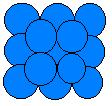
sphere stacking arrangement

sphere stacking arrangement
As shown above, the first layer is placed in a simple square pattern (in this case, a 3 by 3 array). The next layer up is also in a square pattern, offset by half a sphere diameter (in this case, the 2 by 2 array). In order to "seed" the first layer, I drilled a square array of holes in the base platform which forces the first layer into the square pattern. From then on up, the next layers easily follow this stacking pattern.
The idea is to use spheres made of at least two types of material, a structural material and a sacrificial material. Once an entire block is stacked with the two types of spheres, all the spheres are fused together (by gluing or heating) and then the sacrificial spheres are removed (for example, by chemically dissolving them) leaving the structural spheres in the desired shape.
To manufacture a test system, I use an inexpensive CNC milling machine from MAXNC which connects to a PC:

MAXNC 10 mill
The result is the following test platform:
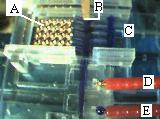
spheres test platform
This platform simply tests the ability to sort two different types of spheres, in this case gold-colored and blue-colored beads. The first "seed" layer of gold-colored spheres is already placed in a 5 by 5 array, shown at A. I am using the same CNC mill as the robotic manipulator, with a pushing rod where the drilling bit usually belongs, shown at B. There is a system of grooves etched into the platform so that the pushing rod can select either a gold-colored sphere from D or a blue-colored sphere from E and line up a new column. Then the pushing plate at C slides to the left and pushes the column into position. This is repeated until the layer is complete. This should all be made more clear with the following videos. (You may have to download the RealPlayer G2.)
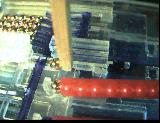
getting a gold-colored sphere
(click to see video)
The first step is to get a gold-colored sphere from the standby area. You can see a red straw filled with gold-colored spheres. At the end of the straw is a vertical stopper which allows one sphere to stick out past the end of the straw. The pushing rod pushes this sphere along the groove in the base and another sphere drops out of the straw in its place. Then, the pushing rod pushes the sphere all the way to begin making a new column which will later be pushed into place.
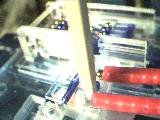
getting a blue-colored sphere
(click to see video)
Following a similar procedure, we next get a blue-colored sphere and push it into the waiting column.
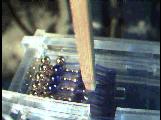
pushing the column into place
(click to see video)
Finally, after placing the last sphere, a sliding push plate pushes the column into place as we build up the layer of spheres column by column.
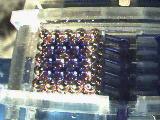
final assembled layer
When the layer is complete, we have an arrangement of gold-colored and blue-colored spheres. You should be able to see a blue square surrounded by gold.
There are two methods for removing the sacrificial spheres. The first is to bond all spheres together and then dissolve away the sacrificial spheres. A second approach is less general but easier to implement: to use a structural material such as lucite with a glue such as methylene chloride which will bond it but will not bond the spheres made of the "sacrificial" material such as polyethylene. In this case, after the glue dries, the sacrificial spheres are shaken loose (and can actually be reused). The disadvantage is that there must be an escape path for all the sacrificial spheres: it would not be possible to make enclosed cavities.
Next I would like to automatically place many layers of spheres. To go beyond the design shown above, which only automates placing spheres in one layer, I plan to build a ramp structure. This way, the supply of spheres can be in a fixed location at the base of the structure and the spheres are pushed up from layer to layer.
back to Voxels Project main page